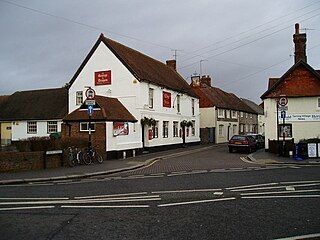This page is based on this
Wikipedia article Text is available under the
CC BY-SA 4.0 license; additional terms may apply.
Images, videos and audio are available under their respective licenses.

Tarring, officially West Tarring, is a neighbourhood of the Borough of Worthing in West Sussex, England. It lies on the A2031 road 1.2 miles (1.9 km) north-west of the town centre. It is called "West Tarring", or less commonly "Tarring Peverell", to differentiate it from Tarring Neville near Lewes.
Mark Robinson may refer to:
Senlac Hill is the generally accepted location where Harold Godwinson deployed his army for the Battle of Hastings on 14 October 1066. It is located near what is now the town of Battle, East Sussex. The name Senlac was popularised by the Victorian historian E.A. Freeman based solely on a description of the battle by the Anglo-Norman chronicler Orderic Vitalis. Freeman went on to suggest that the Normans nicknamed the area Blood lake as a pun on the English Sand lake.
1873 was the 87th season of cricket in England since the foundation of Marylebone Cricket Club (MCC). In only their fourth season as a first-class team, Gloucestershire was proclaimed joint Champion County by the media and went on to claim the still unofficial title four times in five seasons.
1792 was the sixth season of cricket in England since the foundation of Marylebone Cricket Club (MCC). Kent played Hampshire at Cobham Park, which was Lord Darnley’s estate and the home of the Bligh family. Ninety years later it became the home of the Ashes in the shape of the urn brought back from Australia by the Hon. Ivo Bligh.
1793 was the seventh season of cricket in England since the foundation of Marylebone Cricket Club (MCC). Surrey teams defeated All-England three times.
1823 was the 37th season of cricket in England since the foundation of Marylebone Cricket Club (MCC). Henry Bentley issued his Correct Account of all Matches, 1786–1822.
Steven James "Steve" Magoffin is a former Australian cricketer, who most recently played for Worcestershire in English county cricket, and having previously played for Western Australia and Queensland in Australian domestic matches. He has also played county cricket as an overseas player for Surrey and Sussex.
James "Jem" Broadbridge (1795–1843) was an English professional cricketer who is widely accounted the outstanding all-rounder in England during the 1820s. He is best remembered for his part in the introduction of roundarm bowling. He played mainly for Sussex and made 102 known appearances in first-class cricket from 1814 to 1840. He represented the Players in the Gentlemen v Players series and the South in the North v. South series.
Sir George Pearce (1870–1952) was a Western Australian politician.
James Saunders was an English cricketer in the 1820s. He was a left-handed batsman and an occasional wicket-keeper who represented many different teams from 1822 to 1831. In county cricket, he played for Sussex (1823–1825), Kent (1827) and Surrey (1828–1830). He belonged to a cricketing family as his cousins were Richard Searle and his better known brother William Searle.
William Searle was an English cricketer in the 19th century. He was right-handed as a bowler and a fielder but he batted left-handed. Searle played mainly for Surrey. According to Scores and Biographies, he was a "steady and scientific" batsman who was rated one of the "cracks" of his day in a relatively short career.
The roundarm trial matches were a series of cricket matches between Sussex and All-England during the 1827 English cricket season. Their purpose was to help the MCC, as the game's lawgivers, to decide if roundarm bowling should be legalised or if the only legitimate style of bowling should be underarm, which had been in use since time immemorial.

The Sussex Thunder are an American football team from the England based in Brighton, Sussex. The club entered the league for the first time in 1997 when the Crawley Raiders merged with local rivals the Brighton B52s to form a new club the Sussex Thunder. The first Thunder head coach was Jim Jasicki. The Thunder reached the BritBowl Final in their second year where they narrowly lost to the London Olympians under Head Coach Ian Ellis. Success was to be thin afterwards but on 20 September 2008, led by Head Coach Len Scott, the Thunder won the Division 1 national championship in an overtime win against the Redditch Arrows.

Point Danger Light, also known as the Captain Cook Memorial Light, is an active lighthouse located on Point Danger, a headland between Coolangatta, Queensland and Tweed Heads, New South Wales, marking the border between New South Wales and Queensland, Australia. It lays claim to be the first lighthouse in the world to experiment with laser as a light source.
The University of Queensland Art Museum is the art museum and public gallery of The University of Queensland located in the James and Mary Emelia Mayne Centre at the St Lucia, Queensland campus. The University of Queensland Art Collection is now the second largest public art collection in Queensland. The building was formerly known as Mayne Hall.
Richard Stanford may refer to:


